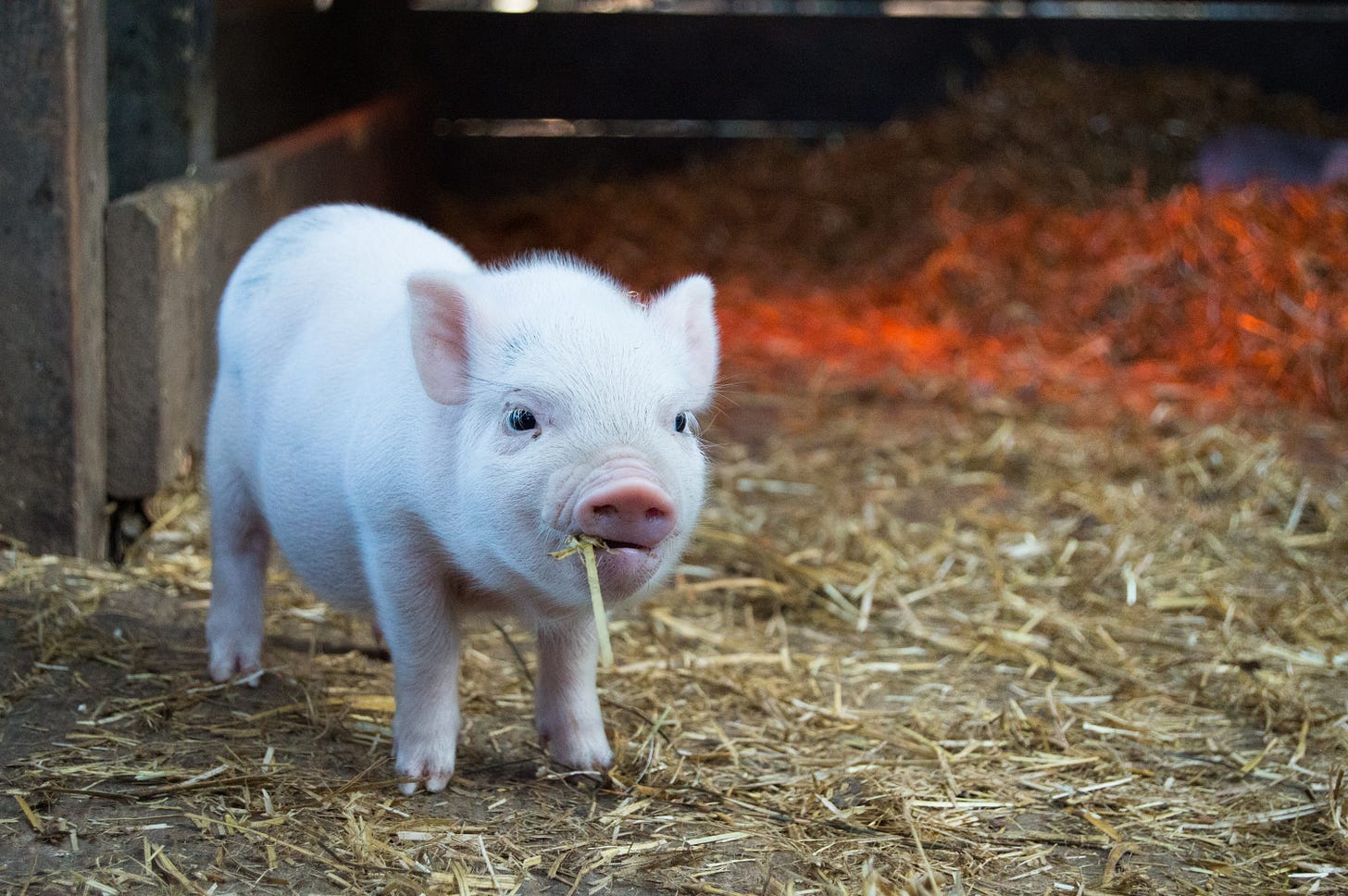Measuring Animal Welfare, Part One: Maybe We Can Just Ask Them?
Doing it the stupid way.
—
It’s often best, when trying to solve a thorny problem, to ask “okay, can we do this the absolutely stupidest way possible?” If we’re trying to figure out what makes humans happy, we usually just ask them.1 If we want to figure out what animals happy, maybe… we can just ask them?
This works surprisingly well, actually.
Carey and Fry (1995) trained pigs that, if they were injected with a drug that caused anxiety, they should press this lever, but if they were injected with a saline solution, they should press that lever. The pigs could then self-report whether they were scared of various situations (audio recordings of a snarling dog, a new ball in their pen, a strange pig, etc).
Pigs are wicked smart. This strategy probably works well for other wicked smart animals—corvids, cetaceans, elephants, primates, dogs—but works less well for other animal species which are not quite so bright. Metacognition is hard, even for humans.
So we can’t necessarily ask most animals what they’re feeling. Can we ask them what they want?
The very stupid way of asking what an animal wants is assuming that if an animal is trying to get something, they want it, and if an animal is trying to avoid something, they don’t want it. The problem with the very stupid way is that it’s hard to figure out strengths of preferences, as opposed to direction. An improvement is to figure out how high a “price” an animal is willing to pay to obtain something. For example, you can figure out how heavy a door an animal will push in order to obtain a certain amount of food, and compare this to how heavy a door an animal will push in order to obtain painkillers.
So what are the problems with this system?
Most obviously, animals often don’t understand things very well. Many animals want to avoid vaccines or to eat too many calories for their health. Humans will often need to override an animal’s short-term preferences for the sake of their long-term well-being.
But you can also have other problems that are hilarious.
For instance, Skinnerian behaviorism isn’t true. You can't condition an animal to do arbitrary things; for many species, if the connection didn't exist in the environment of evolutionary adaptedness, they just won't get it.2 For example, chickens will peck keys in order to receive food, but won't peck keys in order to get litter for their floors. Chickens find this too confusing. Pecking leads to food! Pecking does not lead to floor litter! That makes no sense!
Another problem: the animals do not really understand what they’re being asked to do. For example, when they are put in a hallway so that they can pick between several different rooms, both horses and mice will sometimes decide to stay in the hallway instead (Webster 2005, pg. 53-54). In the mice case, their hallway (actually a tube) was snug and secure and safe, in contrast to the more exposed rooms. In the horse case, the hallway let them look out into a yard, a thing that horses evidently like a lot.
Animals also prefer situations they are familiar with. For example, cows raised on sawdust bedding will sometimes break down a barrier in order to get to the sawdust, while cows raised on sand bedding are indifferent between sand and sawdust. I mean, I also like familiar things, but it does complicate coming up with preference guidelines for the entire species.
Further, asking for preferences is expensive. You have to think of every conceivable thing the animal might want, and then come up with some species-appropriate way to elicit their preferences, and then account for all the other random variables that mess up your nice study. It makes sense to put in the effort for species which are popular as companion animals, farmed animals, or research animals. But isn’t there some way that we can, you know, make generalizations, instead of having to establish for every species that, yes, this one likes food too?
Well, some people have tried, and in the next post we’ll talk about how well it went.
For more on this topic, interested readers may check out Animal Welfare: Limping Towards Eden by John Webster; Understanding Animal Welfare: The Science in Its Cultural Context, by David Fraser; and From an animal’s point of view: Motivation, fitness, and animal welfare, by Marian Stamp Dawkins. The first is my citation for mice and horses’ fondness for hallways.
With varying degrees of subtlety.
Skinner is lucky he decided to do research on pigeons instead of some stupider species.


> For example, chickens will peck keys in order to receive food, but won't peck keys in order to get litter for their floors. Chickens find this too confusing. Pecking leads to food! Pecking does not lead to floor litter! That makes no sense!
Huh, what are other examples of this?
(Also, as Pablo notes, the link to the paper is broken. Guessing you probably linked to some cached copy or something that is now expired?)
Great post! I get access denied for the "pecking keys for litter" study